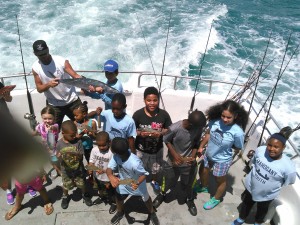Can learning to tie knots and cast lures really help children lead healthy, safe, and fulfilling lives?
Kathleen Elliott thinks so. Amidst the grim backdrop that defines life for many youngsters in Miami-Dade County, she and her husband, Robert O’Bryant, work tirelessly teaching children how to fish and enjoy the outdoors. The payoff, they believe, is that at-risk youth will stay in school, off drugs, and out of the criminal justice system.

Through fishing, Mahogany Youth gives youngsters a positive environment where they learn life skills. Mahogany Youth photo.
Elliott has dozens of stories that illustrate how effective a day on the water can be. “For a lot of our kids, their whole world is an eight-block radius,” she says. “Fishing is the hook we use to get the kids’ attention, and then we’re able to help with modifying their behavior and helping them do goal setting and planning.”
The husband-and-wife team run the Mahogany Youth Corporation, a nonprofit in Miami-Dade County that Florida Sea Grant partners with to help educate youth about the coastal environment, using hands-on activities that stimulate a curiosity about the natural world. Since the organization was founded in 1994, Mahogany Youth has worked with thousands of children, more than 2,700 just last year.
One of its signature programs is “Teach a Child to Fish,” a 20-week clinic based on the successful “Hooked on Fishing Not on Drugs” fishing curriculum. “We’ve actually urbanized and changed it to be more relevant to the kids we’re working with,” Elliott explains. “Basically we teach them how to tie knots and how to fish. We take them out on the water, usually to the Everglades, or right here to the Rickenbacker Bridge, and they get a chance to fish.
“No matter what size fish they catch they get excited. It can be about that big,” Elliott gestures with an index finger quickly approaching her thumb, “and they’re still excited about catching a fish.”
Mahogany Youth’s mission of helping children expand their possibilities through fishing presents a daunting challenge. A recent report commissioned by Miami-Dade County estimates that of the 535,000 children under the age of 18 living in the county, more than half live in low-income or poverty-level homes. Finding funds to implement programs requires that Elliott and O’Bryant continually seek donations, write grants, or partner with a larger organization.

A boat ride on the ocean often means a life-changing moment, Mahogany Youth leaders say. Mahogany Youth photo.
“A simple donation means you change a child’s world forever,” Elliott says. “When they go on an airboat ride into the Everglades, or ride in a boat on the ocean, it starts to expand their possibilities. A child starts to dream about a future that includes fishing and more. We broaden their horizon, we expose them to all kinds of different careers and take them into exploring what it is they really want to do.”
Collaborating with Florida Sea Grant, Elliott says, gets young anglers excited about science and research, and allows the organization to take the fishing lesson one step further. “So many of our kids have never seen science actually being applied. To them it’s something they read in a book,” she says.
“By working with Florida Sea Grant, we’re able to give the kids access to scientific research and have people mentor our kids and give them opportunities to go and do things they might not have had a chance to do.”
In the coming months, plans call for Mahogany Youth students to join researchers funded by Florida Sea Grant on an ongoing sponge restoration project in Florida Bay. The youth are now learning snorkeling and some diving skills in preparation for planting sponges in areas that have been depleted. “They’ll get an actual hands-on experience of science,” Elliott explains. “It’s not just esoteric in a book. They’re actually able to do the experiments and see science in action.”
Editor’s Note: A related feature story about Mahogany Youth Corporation appears in the April 2016 issue of Florida Trend at this link: http://www.floridatrend.com/article/19747/teach-a-child-to-fish



